4-chlorophenacyl thiocyanate
Modify Date: 2025-09-13 09:51:27
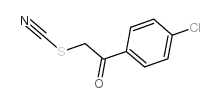
4-chlorophenacyl thiocyanate structure
|
Common Name | 4-chlorophenacyl thiocyanate | ||
|---|---|---|---|---|
| CAS Number | 19339-59-4 | Molecular Weight | 211.66800 | |
| Density | 1.35g/cm3 | Boiling Point | 381.3ºC at 760mmHg | |
| Molecular Formula | C9H6ClNOS | Melting Point | 133-137 °C | |
| MSDS | N/A | Flash Point | 184.4ºC | |
| Name | [2-(4-chlorophenyl)-2-oxoethyl] thiocyanate |
|---|---|
| Synonym | More Synonyms |
| Density | 1.35g/cm3 |
|---|---|
| Boiling Point | 381.3ºC at 760mmHg |
| Melting Point | 133-137 °C |
| Molecular Formula | C9H6ClNOS |
| Molecular Weight | 211.66800 |
| Flash Point | 184.4ºC |
| Exact Mass | 210.98600 |
| PSA | 66.16000 |
| LogP | 2.73698 |
Synonym:None Known Section 2 - COMPOSITION, INFORMATION ON INGREDIENTS
Risk Phrases: 20/21/22 Section 3 - HAZARDS IDENTIFICATION EMERGENCY OVERVIEW
Harmful by inhalation, in contact with skin and if swallowed.The toxicological properties of this material have not been fully investigated. Potential Health Effects Eye: May cause eye irritation. May cause conjunctivitis, ulceration and turbidity of the cornea. Skin: May cause skin irritation. May cause skin sensitization, an allergic reaction, which becomes evident upon re-exposure to this material. Ingestion: May cause irritation of the digestive tract. May cause liver and kidney damage. The toxicological properties of this substance have not been fully investigated. Inhalation: May cause respiratory tract irritation. The toxicological properties of this substance have not been fully investigated. Exposure produces central nervous system depression. In rare instances, exposure may cause sensitization, resulting in inflammation of the mucous membranes and in eczematous eruptions. Chronic: May cause liver and kidney damage. Effects may be delayed. May cause lung damage. Repeated or prolonged exposure may cause allergic reactions in sensitive individuals. Inhalation of product may aggravate existing chronic repiratory problems such as asthma, emphysema or bronchitis. Section 4 - FIRST AID MEASURES Eyes: Immediately flush eyes with plenty of water for at least 15 minutes, occasionally lifting the upper and lower eyelids. Get medical aid. Do NOT allow victim to rub eyes or keep eyes closed. Skin: Get medical aid. Flush skin with plenty of water for at least 15 minutes while removing contaminated clothing and shoes. Wash clothing before reuse. Ingestion: Never give anything by mouth to an unconscious person. Get medical aid. Do NOT induce vomiting. If conscious and alert, rinse mouth and drink 2-4 cupfuls of milk or water. Inhalation: Remove from exposure and move to fresh air immediately. If not breathing, give artificial respiration. If breathing is difficult, give oxygen. Get medical aid. Do NOT use mouth-to-mouth resuscitation. Notes to Physician: For ingestion, the stomach sould be intubated, aspirated, and lavaged with a slurry of activated charcoal--protect the airway from aspiration of gastric contents. Section 5 - FIRE FIGHTING MEASURES General Information: As in any fire, wear a self-contained breathing apparatus in pressure-demand, MSHA/NIOSH (approved or equivalent), and full protective gear. During a fire, irritating and highly toxic gases may be generated by thermal decomposition or combustion. Runoff from fire control or dilution water may cause pollution. Extinguishing Media: Use agent most appropriate to extinguish fire. DO NOT USE WATER! Section 6 - ACCIDENTAL RELEASE MEASURES General Information: Use proper personal protective equipment as indicated in Section 8. Spills/Leaks: Vacuum or sweep up material and place into a suitable disposal container. Clean up spills immediately, observing precautions in the Protective Equipment section. Avoid generating dusty conditions. Provide ventilation. Section 7 - HANDLING and STORAGE Handling: Wash thoroughly after handling. Remove contaminated clothing and wash before reuse. Use with adequate ventilation. Minimize dust generation and accumulation. Avoid contact with eyes, skin, and clothing. Keep container tightly closed. Avoid ingestion and inhalation. Discard contaminated shoes. Storage: Store in a tightly closed container. Store in a cool, dry, well-ventilated area away from incompatible substances. Section 8 - EXPOSURE CONTROLS, PERSONAL PROTECTION Engineering Controls: Facilities storing or utilizing this material should be equipped with an eyewash facility and a safety shower. Use adequate ventilation to keep airborne concentrations low. Exposure Limits CAS# 19339-59-4: Personal Protective Equipment Eyes: Wear chemical splash goggles. Wear appropriate protective eyeglasses or chemical safety goggles as described by OSHA's eye and face protection regulations in 29 CFR 1910.133 or European Standard EN166. Skin: Wear appropriate protective gloves to prevent skin exposure. Clothing: Wear appropriate protective clothing to minimize contact with skin. Respirators: A respiratory protection program that meets OSHA's 29 CFR 1910.134 and ANSI Z88.2 requirements or European Standard EN 149 must be followed whenever workplace conditions warrant respirator use. Section 9 - PHYSICAL AND CHEMICAL PROPERTIES Physical State: Solid Color: Not available. Odor: odorless pH: Not available. Vapor Pressure: Not available. Viscosity: Not available. Boiling Point: Not available. Freezing/Melting Point: Not available. Autoignition Temperature: Not available. Flash Point: Not available. Explosion Limits, lower: Not available. Explosion Limits, upper: Not available. Decomposition Temperature: Solubility in water: Partially soluble. Specific Gravity/Density: Molecular Formula: C9H6ClNOS Molecular Weight: 211.5611 Section 10 - STABILITY AND REACTIVITY Chemical Stability: Stable under normal temperatures and pressures. Conditions to Avoid: Incompatible materials, excess heat, strong oxidants, exposure to moist air or water. Incompatibilities with Other Materials: Strong oxidizing agents, strong acids, strong bases, amines. Hazardous Decomposition Products: Hydrogen chloride, hydrogen cyanide, carbon monoxide, oxides of nitrogen, oxides of sulfur, irritating and toxic fumes and gases, carbon dioxide, hydrocarbons. Hazardous Polymerization: Has not been reported. Section 11 - TOXICOLOGICAL INFORMATION RTECS#: CAS# 19339-59-4 unlisted. LD50/LC50: Not available. Carcinogenicity: 4-Chlorophenacyl Thiocyanate - Not listed by ACGIH, IARC, or NTP. Section 12 - ECOLOGICAL INFORMATION Section 13 - DISPOSAL CONSIDERATIONS Dispose of in a manner consistent with federal, state, and local regulations. Section 14 - TRANSPORT INFORMATION IATA Shipping Name: TOXIC LIQUID, ORGANIC, N.O.S.* Hazard Class: 6.1 UN Number: 2810 Packing Group: III IMO Shipping Name: TOXIC LIQUID, ORGANIC, N.O.S. Hazard Class: 6.1 UN Number: 2810 Packing Group: III RID/ADR Shipping Name: TOXIC LIQUID, ORGANIC, N.O.S. Hazard Class: 6.1 UN Number: 2810 Packing group: III Section 15 - REGULATORY INFORMATION European/International Regulations European Labeling in Accordance with EC Directives Hazard Symbols: XN Risk Phrases: R 20/21/22 Harmful by inhalation, in contact with skin and if swallowed. Safety Phrases: S 24/25 Avoid contact with skin and eyes. S 36/37 Wear suitable protective clothing and gloves. WGK (Water Danger/Protection) CAS# 19339-59-4: No information available. Canada None of the chemicals in this product are listed on the DSL/NDSL list. CAS# 19339-59-4 is not listed on Canada's Ingredient Disclosure List. US FEDERAL TSCA CAS# 19339-59-4 is not listed on the TSCA inventory. It is for research and development use only. SECTION 16 - ADDITIONAL INFORMATION N/A |
| Hazard Codes | Xn: Harmful;Xi: Irritant; |
|---|---|
| Risk Phrases | R36/37/38 |
| Safety Phrases | S36/37/39-S26 |
| HS Code | 2930909090 |
| Precursor 9 | |
|---|---|
| DownStream 8 | |
| HS Code | 2930909090 |
|---|---|
| Summary | 2930909090. other organo-sulphur compounds. VAT:17.0%. Tax rebate rate:13.0%. . MFN tariff:6.5%. General tariff:30.0% |
| Thiocyanic Acid 2-(4-Chlorophenyl)-2-Oxoethyl Ester |
| MFCD00019771 |
| 4-Chlorophenacylthiocyanate |
| 1-(4-chlorophenyl)-2-thiocyanatoethanone |
| EINECS 242-972-0 |
| [2-(4-chlorophenyl)-2-oxoethyl]thiocarbonitrile |
| 2-(4-Chlorophenyl)-2-oxoethyl thiocyanate |
| 4-CHLOROBENZOYLMETHYL THIOCYANATE |
| 4-Chlorophenacyl thiocyanate |
| 4'-chloro-2-thiocyanatoacetophenone |
 CAS#:333-20-0
CAS#:333-20-0 CAS#:536-38-9
CAS#:536-38-9 CAS#:99-91-2
CAS#:99-91-2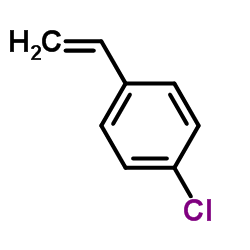 CAS#:1073-67-2
CAS#:1073-67-2 CAS#:344790-87-0
CAS#:344790-87-0 CAS#:1124-15-8
CAS#:1124-15-8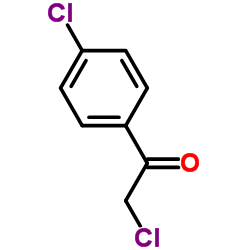 CAS#:937-20-2
CAS#:937-20-2![[2-(4-chlorophenyl)-2-oxoethyl] 4-methylbenzenesulfonate Structure](https://image.chemsrc.com/caspic/114/25917-49-1.png) CAS#:25917-49-1
CAS#:25917-49-1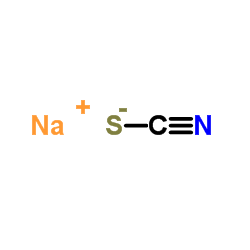 CAS#:540-72-7
CAS#:540-72-7 CAS#:2103-96-0
CAS#:2103-96-0 CAS#:956-02-5
CAS#:956-02-5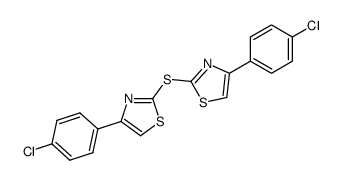 CAS#:79576-74-2
CAS#:79576-74-2 CAS#:2104-00-9
CAS#:2104-00-9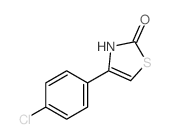 CAS#:2103-98-2
CAS#:2103-98-2![1-(4-chlorophenyl)-2-[2-(4-chlorophenyl)-2-oxo-ethyl]disulfanyl-ethanone structure](https://image.chemsrc.com/caspic/468/5409-94-9.png) CAS#:5409-94-9
CAS#:5409-94-9 CAS#:39564-86-8
CAS#:39564-86-8